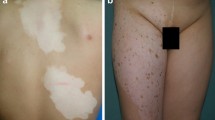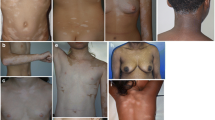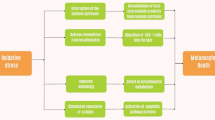Summary
Vitiligo is an acquired depigmentary skin disorder of unknown origin characterized by well-demarcated, white macules of varying size and distribution. Despite relevant new research and progresses, why melanocytes disappear to induce the characteristic achromic lesions of vitiligo is not fully understood. In spite of recent findings implicating genetic, immune and oxidative stress factors, the exact pathogenesis of vitiligo remains obscure. An innovative concept based on a functional cross-talk between the nervous and immune system is emerging. Neuropeptides released from peripheral nerve endings could synergize with new cytokines to adversely affect melanocyte function and viability. Evidence is increasing regarding the role of neuropeptides in the pathogenesis of vitiligo and a new winning approach to vitiligo therapy based on neuropeptides regulation is at the horizon.
Zusammenfassung
Die Vitiligo ist eine erworbene pigmentäre Hauterkrankung unbekannter ätiologie, welche von gut abgegrenzten weißen Hautflecken unterschiedlicher Größe und Verteilung gekennzeichnet ist. Ungeachtet neuer, relevanter Forschungen und Erkenntnisfortschritte ist der Grund für das Abnehmen von Melanozyten und die Induktion der charakteristischen pigmentarmen Läsionen der Vitiligo nicht hinreichend geklärt. Trotz rezenter Erkenntnisse im Bezug auf genetische, immunologische und oxidative Stressfaktoren ist die genaue Pathogenese der Vitiligo unklar. Im Entstehen begriffen ist ein innovatives Konzept, das auf die gegenseitige funktionelle Beeinflussung zwischen dem Nerven- und Immunsystem aufbaut. So könnten von peripheren Nervenenden ausgehende Neuropeptide mit neuen Zytokinen synergieren und sich negativ auf die melanozytische Funktions- und Entwicklungsfähigkeit auswirken. Die wachsende Evidenz im Hinblick auf die Bedeutung von Neuropeptiden bei der Pathogenese der Vitiligo geht mit einem neuen, gewinnbringenden Ansatz in der Vitiligotherapie auf der Basis der Neuropeptidenregulation einher.
Similar content being viewed by others
References
Laddha NC, Dwivedi M, Mansuri MS, Gani AR, Ansarullah M, Ramachandran AV, Dalai S, Begum R. Vitiligo: interplay between oxidative stress and immune system. Experimental Dermatology. 2013;22:245–50.
Lotti T, Hercogova J, editors. Vitiligo: problems and solutions. New York: Marcel Dekker; 2004. S. 323–34.
Taieb A, Alomar A, Böhm M, Dell’anna ML, De Pase A, Eleftheriadou V, Ezzedine K, Gauthier Y, Gawkrodger DJ, Jouary T, Leone G, Moretti S, Nieuweboer-Krobotova L, Olsson MJ, Parsad D, Passeron T, Tanew A, van der Veen W, van Geel N, Whitton M, Wolkerstorfer A, Picardo M. The writing group of the Vitiligo European Task Force (VETF) in cooperation with the European Academy of Dermatology and Venereology (EADV) and the Union Européenne des Médecins Spécialistes (UEMS). Guidelines for the management of vitiligo: the European Dermatology Forum consensus. Br J Dermatol. 2013;168(1):5–19.
Lotti T, D’Erme AM. Vitiligo: a systemic disease. Clin Dermatol. 2014;32(3):430–34.
Hercogová J, Schwartz RA, Lotti TM. Classification of vitiligo: a challenging endeavor. Dermatol Ther. 2012;25(Suppl 1):10–6.
Ezzedine K, Lim HW, Suzuki T, Katayama I, Hamzavi I, Lan CC, Goh BK, Anbar T, Silva de Castro C, Lee AY, Parsad D, van Geel N, Le Poole IC, Oiso N, Benzekri L, Spritz R, Gauthier Y, Hann SK, Picardo M, Taieb A. Vitiligo Global Issue Consensus Conference Panelists. Revised classification/nomenclature of vitiligo and related issues: the Vitiligo Global Issues Consensus Conference. Pigment Cell Melanoma Res. 2012;25(3):E1–13.
Ongenae K, Van Geel N, Naeyaert JM. Evidence for an autoimmune pathogenesis of vitiligo. Pigment Cell Res. 2003;16(2):90–100.
Linthorst Homan MW, Sprangers MA, de Korte J, Bos JD, van der Veen JP. Characteristics of patients with universal vitiligo and health-related quality of life. Arch Dermatol. 2008;144(8):1062–4.
Hann SK, Lee HJ. Segmental vitiligo: clinical findings in 208 patients. J Am Acad Dermatol. 1996;35(5 Pt 1):671–4.
Le Poole IC, Luiten RM. Autoimmune etiology of generalized vitiligo. Curr Dir Autoimmun. 2008;10:227–43.
Alikhan A, Felsten LM, Daly M, Petronic-Rosic V. Vitiligo: a comprehensive overview Part I. Introduction, epidemiology, quality of life, diagnosis, differential diagnosis, associations, histopathology, etiology, and work-up. J Am Acad Dermatol. 2011;65(3):473–91.
Kemp EH, Waterman EA, Weetman AP. Autoimmune aspects of vitiligo. Autoimmunity. 2001;34:65–77.
Mandelcorn-Monson RL, Shear NH, Yau E, Sambhara S, Barber BH, Spaner D, De Benedette MA. Cytotoxic T lymphocyte reactivity to gp100, MelanA/MART-1, and tyrosinase, in HLA-A2-positive vitiligo patients. J Invest Dermatol. 2003 Sep;121(3):550–6.
Steitz J, Wenzel J, Gaffal E, Tuting T. Initiation and regulation of CD8 + T cells recognizing melanocytic antigens in the epidermis: implications for the pathophysiology of vitiligo. Eur J Cell Biol. 2004;83(11–12):797–803.
Harning R, Cui J, Bystryn JC. Relation between the incidence and level of pigment cell antibodies and disease activity in vitiligo. J Invest Dermatol. 1991;97(6):1078–80.
Farrokhi S, Hojjat-Farsangi M, Noohpisheh MK, Tahmasbi R, Rezaei N. Assessment of the immune system in 55 Iranian patients with vitiligo. J Eur Acad Dermatol Venereol. 2005;19(6):706–11.
Lotti T, D’Erme AM, Hercogova J. The role of neuropeptides in the control of regional immunity. Clin Dermatol. (In press).
Roosterman D, Goerge T, Schneider SW, Bunnett NW, Steinhoff M. Neuronal control of skin function: the skin as a neuroimmunoendocrine organ. Physiol Rev. 2006;86(4):1309–79.
Al’Abadie MSK, Senior HJ, Bleehen SS, Gawkrodger DJ. Neuropeptide and neuronal marker studies in vitiligo. Br J Dermatol. 1994;131:160–5.
Nellhiius G, Acquired unilateral vitiligo and poliosis of the head and subacute encephalitis with partial recovery. Neurology. 1970;20:965–74.
Silvan M. The psychological aspects of vitiligo. Cutis. 2004;73(3):163–7.
Lotti T, Bianchi B, Ghersetich I, Brazzini B, Hercogova J. Can the brain inhibit inflammation generated in the skin? The lesson of gamma-melanocyte-stimulating hormone. Int J Dermatol. 2002;41(6):311–8.
Lotti T, Hautmann G, Panconesi E. Neuropeptides in skin. J Am Acad Dermatol. 1995;33(3):482–96.
Lotti T, Bianchi B, Panconesi E. Neuropeptides and skin disorders. The new frontiers of neuro-endocrine-cutaneous immunology. Int J Dermatol. 1999;38(9):673–5.
Urpe M, Pallanti S, Lotti T. Psychosomatic factors in dermatology. Dermatol Clin. 2005;23(4):601–8.
Urpe M, Buggiani G, Lotti T. Stress and psychoneuroimmunologic factors in dermatology. Dermatol Clin. 2005;23(4):609–17.
Vrijman C, Hosseinpour D, Bakker JG, Wolkerstorfer A, Bos JD, van der Veen JP, Luiten RM. Provoking factors, including chemicals, in Dutch patients with vitiligo. Br J Dermatol. 2013;168(5):1003–11.
Moretti S, Arunachalam M, Colucci R, Pallanti S, Kline JA, Berti S, Lotti F, Lotti T. Autoimmune markers in vitiligo patients appear correlated with obsession and phobia. J Eur Acad Dermatol Venereol. 2012;26(7):861–7.
D’Erme AM, Zanieri F, Campolmi E, Santosuosso U, Betti S, Agnoletti AF, Cossidente A, Lotti T. Therapeutic implications of adding the psychotropic drug escitalopram in the treatment of patients suffering from moderate-severe psoriasis and psychiatric comorbidity: a retrospective study. J Eur Acad Dermatol Venereol. 2012 Sep 11.
Farber EM. Psychoneuroimmunology and dermatology. Int J Dermatol. 1993;32:93–4.
Falabella R, Barona MI, Echeverri IC, Alzate A. Substance P may play a part during depigmentation in vitiligo. A pilot study. J Eur Acad Dermatol Venereol. 2003 May;17(3):355–6.
Slominski A, Wortsman J, Tuckey RC, Paus R. Differential expression of HPA axis homolog in the skin. Mol Cell Endocrinol. 2007;265–266:143–9.
Theoharides TC, Donelan JM, Papadopoulou N, Cao J, Kempuraj D, Conti P. Mast cells as targets of corticotropin-releasing factor and related peptides. Trends Pharmacol Sci. 2004;25(11):563–8.
Slominski A, Wortsman J, Pisarchik A, Zbytec B, Linton EA, Mazurkiewicz JE, Wei ET. Cutaneous expression of corticotrophin releasing hormone (CRH), urocortin and CRH receptors. FASEB J. 2001;15(10):1678–93.
Slominski AT, Tobin DJ, Shibahara S, Wortsman J. Melanin pigmentation in mammalian skin and its hormonal regulation. Physiol Rev. 2004;84:1155–228.
Kingo K, Aunin E, Karelson M, Philips MA, Rätsep R, Silm H, Vasar E, Soomets U, Kõks S. Gene expression analysis of melanocortin system in vitiligo. J Dermatol Sci. 2007;48(2):113–22.
Reimann E, Kingo K, Karelson M, Salum T, Aunin E, Reemann P, Abram K, Vasar E, Silm H, Kõks S. Analysis of the expression profile of CRH-POMC system genes in vitiligo skin biopsies. J Dermatol Sci. 2010;60(2):125–8.
Al-Hashimi M, Scott SW, Thompson JP, Lambert DG. Opioids and immune modulation: more questions than answers. Br J Anaesth. 2013;111(1):80–8.
Hristakieva E, Lazarova R, Lazarov N, et al. Markers for vitiligo related neuropeptides in human skin nerve fibres. Acta Med Croatica. 2000;54:53–7.
Miniati A, Weng Z, Zhang B, Therianou A, Vasiadi M, Nicolaidou E, Stratigos AJ, Antoniu C, Theoharides TC. Stimulated human melanocytes express and release interleukin-8, which is inhibited by luteolin: relevance to early vitiligo. Clin Exp Dermatol. 2014;39(1):54–7.
Luger TA, Schwarz T. Evidence for an epidermal cytokine network. J Invest Dermatol. 1990;95:100–4.
Schallreuter KU, Bahadoran P, Picardo M, et al. Vitiligo pathogenesis: autoimmune disease, genetic defect, excessive reactive oxygen species, calcium imbalance, or what else? Exp Dermatol. 2008;17:139–40.
Conflict of interest
The authors declare any affiliation or significant financial involvement in any organizations or entity with a direct financial interest in the subject matter or materials discussed in the manuscript on this page.
Author information
Authors and Affiliations
Corresponding author
Rights and permissions
About this article
Cite this article
Lotti, T., Zanardelli, M. & D’Erme, A. Vitiligo: what’s new in the psycho-neuro-endocrine-immune connection and related treatments. Wien Med Wochenschr 164, 278–285 (2014). https://doi.org/10.1007/s10354-014-0288-7
Received:
Accepted:
Published:
Issue Date:
DOI: https://doi.org/10.1007/s10354-014-0288-7




